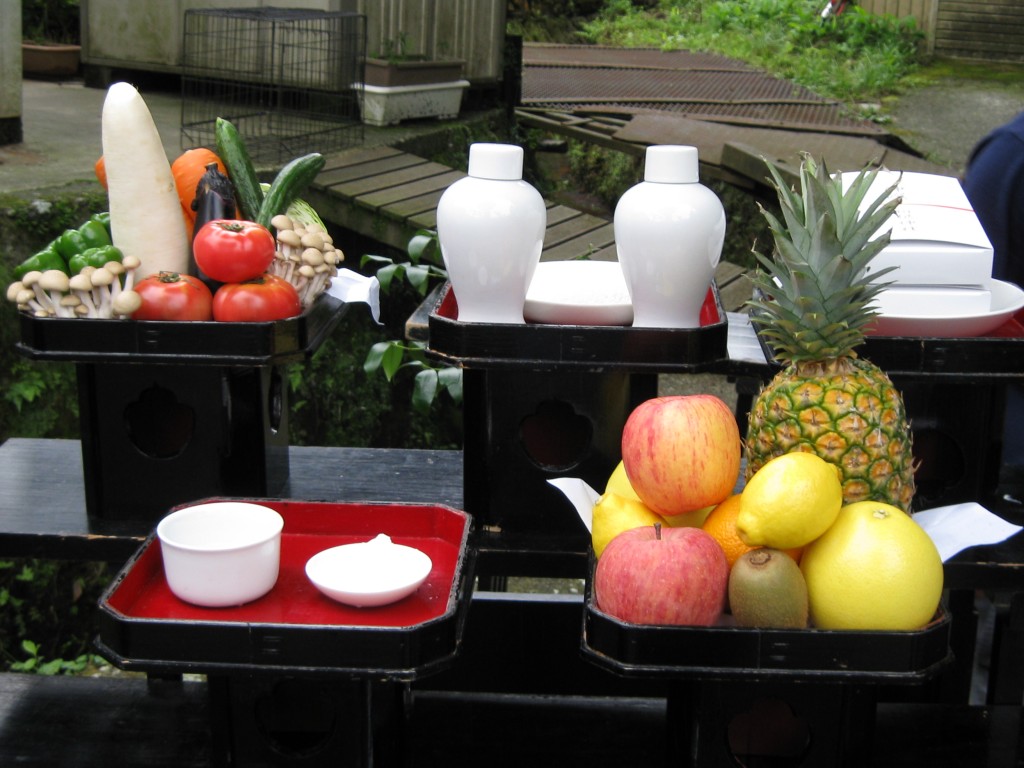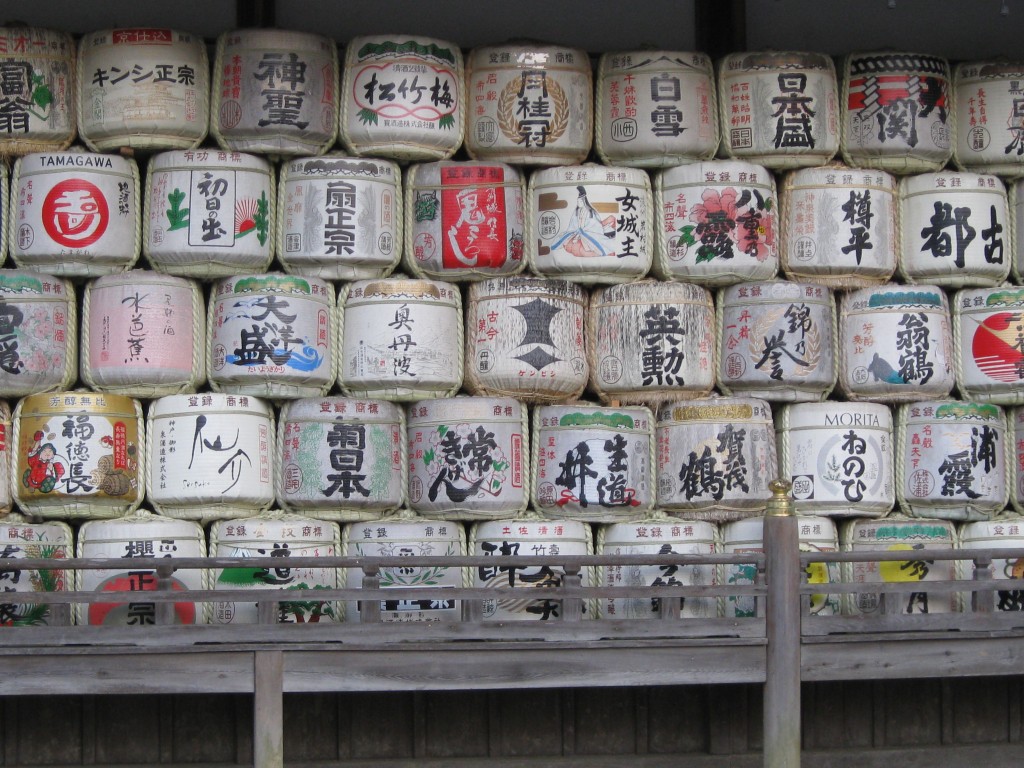
Offerings can take many forms and be visually appealing. E-money lacks substance and aesthetics.
E-money contributions to shrine donations. A shocking break with tradition, or an example of Shinto adapting to the times?
The worldwide pressure to move to a cashless society, and the consequent focussing on Japan as languishing behind in this respect, is having an effect on the Shinto world today. Is swiping a card enough to make an offering? It hardly has any sense of ’offering’, even less of self-sacrifice. The complications are even greater than that, for technically the offering is made to the kami, not to the shrine priests. How pleased will the kami be by a credit card?
Nonetheless such is the force of progress that some shrines are already making provision for e-money donations, as the pieces below indicate. Change within continuity has long been the Japanese view of things, and it’s certainly been a keynote of Shinto’s ability to survive too.

A hungry frog makes an inviting bid for offerings
“””””””””””””
’Although we initially encountered criticism, an increasing number of people now support e-money offerings thanks partly to the government’s efforts to promote cashless payments.’
Rie Matsuoka, an official at Atago Jinja, a Shinto shrine in Tokyo’s Minato Ward, which started in 2014 to accept offerings by e-money Rakuten Edy as a countermeasure to theft. In Japan, people throw some coins into a saisen (wooden donation box) when they visit a shrine or temple as they pray for their wishes to be realized.
© Jiji Press Japan Today, Jan 3, 2019
“””””””””””””””””””

A visitor offers saisen monetary offerings using Rakuten Edy at Atago Jinja shrine in Minato Ward, Tokyo, on Jan. 4, 2017. (courtesy Jiji)
— The number of shrines and temples in Japan that accept saisen monetary offerings via e-money is increasing as the country moves toward a cashless society.
While some welcome the trend as a convenient way, others are critical of e-money use at religious places.
Atago Jinja, a Shinto shrine in Tokyo’s Minato Ward, started in 2014 to accept saisen via Rakuten Edy, a type of e-money, as a countermeasure to saisen theft.
In Japan, people throw some coins or even bills into a wooden donation box as saisen when they visit a shrine or temple and pray for their wishes to be realized, including during the New Year period.
“Although we initially encountered criticism, an increasing number of people now support e-money offerings thanks partly to the government’s efforts to promote cashless payments,” said Rie Matsuoka, a 52-year-old Atago Jinja official.
“In the past, offerings had been made in kind, such as rice and fish, and then cash took their place,” she explains. “It makes no difference to offer saisen in cash or e-money.”
In 2019, Atago Jinja will accept e-money saisen only on Friday, the first business day of the year.
Nikko Futarasan-Jinja, a Shinto shrine and one of the UNESCO World Heritage sites in Nikko, Tochigi Prefecture, introduced an electronic payment system in October 2018, aiming to allow visitors to offer saisen via e-money amid an increase in the number of tourists from China, where e-money is a popular payment method.
The shrine set up signboards with a quick response code at some 10 locations on its premises to allow visitors to scan the QR code with their smartphones for offering saisen by e-money.
“Electronic settlements are a trend of the times,” said Yoshifumi Saito, a 66-year-old official at the shrine.
“We expect saisen offerings by e-money will increase in February, when many Chinese people are expected to visit the shrine during China’s Lunar New Year holidays.”
Kaigenji, a temple in Fukuchiyama, Kyoto Prefecture, introduced an electronic settlement system in October 2018, hoping to lure young people who do not usually visit temples.
“Donation by e-money is as worthy as by cash,” said Mitsuhiro Shibahara, 38-year-old chief priest at the temple.
“We want young people to feel close to temples by using the interesting way of giving saisen via e-money,” he adds.
On the internet, many people praise e-money use for saisen, citing the convenience of the method. Some pointed to reward or mileage points as benefits.
Among opponents, meanwhile, some say they do not feel comfortable making monetary offerings by electronic data at shines or temples, and others argue that it appears disrespectful to use e-money at such sacred places.
“In the first place, blessings are not something given in return for money,” said a public relations official of Jinja Honcho, or the Association of Shinto Shrines.
“The important thing is that people express a sense of gratitude for the fulfillment of their wishes,” the official says, adding, “Our minds determine whether blessings will be given or not.”

Offerings in traditional style – quite a contrast to an e-offering

Whether the Jinja Honchō likes it or not, it’s going to happen, and probably sooner rather than later because many cash strapped jinja will not want to turn offerings away. The argument that blessings are not sold for money isn’t very convincing because whether you give cash, or e-money, or rice, you still worked an equal amount to obtain them. The effort/sacrifice is in doing the initial work, not the actual donation.
Personally, I would like to see jinja more open to having websites where you could donate and receive Ōfuda, Ōmamori, hamaya, etc. There are many people not living in Japan that would like to receive these from jinja that aren’t represented in their country. I can understand that these shouldn’t be purchased as a collectable, but a simple series of check boxes would at least let people know that these are items used to practice Shinto. The method would be similar to software agreements, except there would be only one or at most two sentences per check box item. After all, nothing stops a person from going to a jinja and obtaining them to be used as a collectable. I’m not sure how Fushimi Inari Taisha could handle wakemitama, other than the current way* since obtaining one is a serious commitment, so that is not very likely to ever change.
* Going in person, having an interview, and receiving training on the proper care.
Thank you for the thoughtful response. I can’t help feeling that digital is insubstantial. There’s a parallel I think between the ancient practice of gifting a horse to a shrine and substituting it with an ema. The ema is a symbol of the horse. Similarly money is a symbol of the products that used to be offered, whether cloth or paper strips or whatever. And in the physical act of giving, one feels a contribution. On the other hand, when I go shopping with a credit card, I have no feel of passing over something – it feels indeed as if I got the merchandise for nothing. Of course that’s an illusion, but one that consumerism is all too eager to promote. It seems a pity for shrines to go down the same route as supermarkets, but I guess that’s the age in which we live… Better that than live horses anyway, imho!
If the only time a person thinks about the donation is when the donation is made (and I suspect that’s the case for many people), the insubstantial feeling becomes a very valid point and I agree. Some thought should be involved, which is why jinja have envelopes to enclose the money. Putting the money in an envelope slows down the process and creates a bit of think time. Of course, putting the original offering products creates even more think time, but most folks don’t grow their own rice or spin the threads to make cloth these days. In my opinion, the way most in accordance with a Shinto lifestyle–as I understand Shinto lifestyle–is to think about the donation and your connection with Okamisama while doing the work. Then the process of donating and receiving becomes a small component of the entire offering process and the speed with which it happens doesn’t matter.